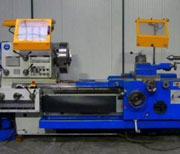Machining, metalworking
We are also able to assist customers with small volume or special metalworking orders at our facilities. This is classic machining on traditional machine tools.
Machining by conventional turning
Among our machining services we offer roughing and conventional turning of materials, which we carry out on centre lathes from 30 mm in diameter up to a maximum diameter of 600 mm and a length of 1500 mm.
Our other specialisation is the production of thick-walled housings. The machining technology enables the production of bushings according to customer specifications, from D/d 40/20 to the maximum dimension: D/d 550+1/268-2 mm and length 1000 mm.
We offer classic metalworking from 1 piece.
Technical support of machining:- SUS 50, SU 63, SU 63, SU 63A, SU 80, SU 80A

Surface roughening by milling
Roughing is carried out on conventional duplex milling machines up to a maximum profile width or height of 400 mm and a length of 1250 mm.
Technical support of machining:- FS 36, FBDW 400

History of metalworking
Metalworking has accompanied man since time immemorial. At first with primitive tools, even without fire, man tried to create his first tools, weapons, ornaments and other objects to make his life easier or to help him survive in the inhospitable nature.
According to historians the first metal to be worked was gold, which could be found in the wild as a pure metal. Other metals such as copper, tin, iron are present in nature as ores, so their processing must have been preceded by the first discoveries in the field of metallurgy.
Bronze machining
Bronze is an alloy of copper and tin. Copper itself is too soft for tools or weapons that require sharp edges and a certain degree of rigidity. When tin is added to molten copper, bronze is "formed" and can be easily machined into shapes with the desired properties. This discovery led to the tremendous progress of civilisation. The machining of bronze is relatively easy compared to the subsequent steel.
Iron working
The discovery of iron production technologies was mainly due to the depletion of readily available copper and tin deposits. Iron ores are much more abundant in the Earth’s crust than copper and tin. Subsequently, with the spread of iron metallurgy, significant progress was made in the machining of this metal. Along with the development of steel production and steel machining, the late 19th and early 20th centuries saw an unprecedented flowering of human civilisation, industry and technology.



